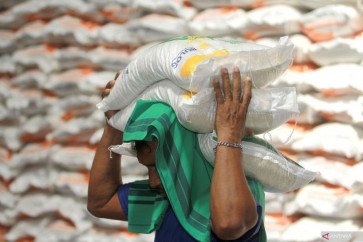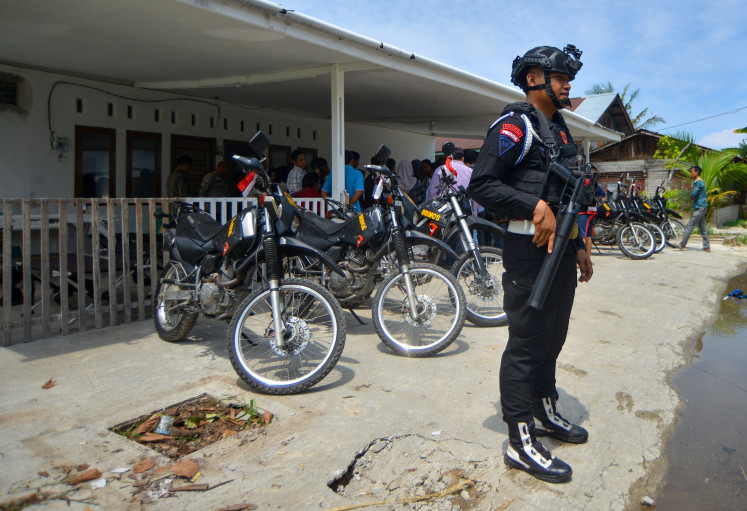Popular Reads
Top Results
Can't find what you're looking for?
View all search resultsPopular Reads
Top Results
Can't find what you're looking for?
View all search resultsRacing through Venice of the East
Indonesian Independence Day celebrations in the South Sumatran capital Palembang are the time to watch the Perahu Bidar traditional boat race
Change text size
Gift Premium Articles
to Anyone
I
ndonesian Independence Day celebrations in the South Sumatran capital Palembang are the time to watch the Perahu Bidar traditional boat race.
The contestants usually come from government offices and private institutions, from both Palembang city and other regencies and cities in the province.
The competition always draws a large crowd to the competition, which begins at Pelabuhan 35 Ilir port and finishes near Pusri on the Musi River.
Each Perahu Bidar boat, made from the trunk of a huge hardwood tree, is brightly colored and adorned with distinctive decorations. At the stern, the dominant feature is a snakehead carving, representing the Sriwijaya Kingdom, with the Indian influences evident in the cobra.
Other contestants in the boat race use a pancalang boat, which means it can move fast. These boats are between 10 and 20 meters long and can hold up to 50 people, including the commander and a gong striker, who is called the boat boss.
According to Palembang historian Djohan Hanafiah, each pancalang boat is made from one piece of timber; historically, they were used in various regions around South Sumatra to transport people and goods along the rivers.
These boats were also often used for patrols and recreation and for couriers to deliver messages to the kings.
"The pancalang boats were the original Bidar boats," Djohan said. "The race is staged in an effort to preserve our culture."
These boats are distinctive for their triangular roofs and the rudder at the stern. During the race, the contestants use a bamboo pole, which serves as an oar.
It's not known when the Bidar race tradition began but, as it features in records from the Dutch administration in 1925 and the Palembang Sultanate, the race has been around for some time.
During the Dutch colonial era, the race was held to celebrate the king's or the queen's birthday; during the time of the Palembang Sultanate, it was held on important days in the Islamic calendar and after Idul Fitri.
The Palembang community calls the Bidar competition kenceran or plenceran.
But the modern Bidar boats are different from those of yesteryear, most markedly in their size: They are now bigger and longer. Some are more than 12 meters long and can carry 24 people; others reach 29 meters long and take 75 people.
Other traditions the participants follow include hanging an epigraph stone taken from an area of Kedukan Bukit.
The Kedukan Bukit Epigraph is one of the relics of the Sriwijaya Kingdom and is found in 35 Ilir, a subdistrict in Palembang. The epigraph was written in Pallawa characters in the old Malay language and was found in Batenburg in 1920.
Some residents believe the Bidar competition started from there.
"The legends, the stories, are part of our various traditions," said Djohan.
The Bidar competition is also part of Palembang's history, as the rivers are intimately connected with the city's history.
In his book Palembang Bari Period (Palembang's Olden Days), Djohan wrote that in the past, Palembang had more than a hundred tributaries.
This environment eventually became Palembang city where the land is always melembeng (having water), making Palembang becoming a place that has water - or pelembeng.
The name Palembang itself first appeared between the 7th and 12th centuries, before the fall of the Sriwijaya Kingdom.
Originally, the community called it lembeng, which means a water puddle, while the prefix "pa" refers to place. So when it was combined to become Palembang, it became a significant city that always has puddles of water.
"In the Dutch period, Palembang city was called the City of 20 Islands *de sta der teintig eilanden*; another name was Venice of the East. The existence of Musi river, which flows through the area of Seberang Ulu and Seberang Ilir Palembang, suggests that it is similar to Venice, the Italian city," he said.
As a tourist attraction, the Bidar competition has become one of the mainstays in Palembang city's bid to attract tourists.
But according to Djohan, the time has come to modify the competition to make it more interesting.
"If there is no creative touch and no new breakthroughs in the arrangement, then this competition will just remain a tradition and still be monotonous," he said. "It's now time to make it like other boat races, like dragon boats at an international level."










